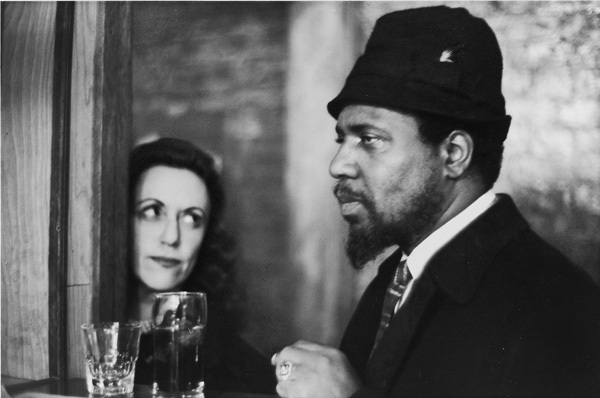When Hannah Rothschild first met her great-aunt Nica it was 1984. Hannah was 22, and Nica, then 70, had asked her to come sometime after midnight to a basement jazz club in an area of pre-Giuliani downtown Manhattan ‘known for its crack dens and muggings’. She was able to find the venue, as promised, by the pale blue Bentley parked erratically outside and inhabited by a couple of drunks. Inside, her aunt, ‘the Baroness’, was easily identifiable as the only white person: a wizened old doll in a fur coat with a a long black-filter cigarette, drinking whisky out of a teapot.
Nica — or to give her correct title, gained through marriage to a dullish Austrian-French toff, Baroness Pannonica de Koenigswarter — was by this stage what her great-niece wittily identifies as ‘the Miss Havisham of Bebop’. As legend had it (a legend that she cultivated), she was passing through New York at the end of the 1940s en route back to her husband’s diplomatic posting in Mexico, when she heard a recording of Thelonius Monk’s ‘Round Midnight’ and decided that her purpose in life was to meet and nurture the man playing. She had what she called ‘a call’. She never got on the plane back.
The story that Hannah Rothschild tells in her bright, clear prose is a mixture of things — nearly a biography of Nica, nearly a biography of Thelonious Monk, nearly a sketch of the 1950s New York jazz scene. At one level it’s a version of The Hare with Amber Eyes (though without that book’s wearying preciosity): the scion of a European dynasty ancestor-hunting like a posh literary version of Who Do You Think You Are? The first third of it is a run-down of the history of the Rothschilds, enlivened by personal memories and Hannah’s exchanges with her great-aunt Miriam, entomologist and custodian of the family secrets.
The family history is quite something: the Rothschilds went from ghetto Jewry to bankrolling Europe’s wars within a couple of generations, enjoying vast opulence (and indulging enthusiasms such as riding on giant tortoises, hurtling around in carriages drawn by zebras and amassing unparalleled collections of art and stuffed animals) but remaining also, woundingly, half outside the social pale. Nica’s father Charles, looking back on his days at Harrow, wrote:
If I ever have a son, he will be instructed in boxing and ju-jitsu before he enters school, as ‘Jew hunts’, such as I experienced, are a very one-sided amusement and there is apt to be lack of sympathy between the hunters and the hunted.
Family traits included eccentricity, secrecy, and — possibly exacerbated by inbreeding — mental illness. Charles, who worked in the family firm but really preferred collecting butterflies (‘Pannonica’ is a type of moth) killed himself, and his suicide was never spoken of. Nor, without much perseverance, was Nica’s delinquency. The family bailed her out when she needed it, and kept discreetly in touch. But it wasn’t done to abandon your husband and children to become a jazz groupie. From her arrival in New York, Nica became a new person: ‘the Baroness’. She took suites in posh midtown hotels until they threw her out for inviting black musicians up for all-night jam sessions, and finally settled in a New Jersey apartment with more than 300 cats. She slept all day and spent all night at jazz clubs — and continued to do so long after the caravan had, effectively, moved on.
Nica was the dedicatee of a couple of dozen jazz records and was represented in Clint Eastwood’s movie, Bird, about Charlie Parker, as well as in a couple of documentaries, Straight, No Chaser, about Monk, and Hannah Rothschild’s BBC Storyville programme, The Jazz Baroness. She helped dozens of artists with money, friendship, a place to sleep, a ride to a gig in her drop-head Bentley (which she drove fast and terrifyingly badly), a place to crash or jam, and when they were in trouble with the law. Charlie Parker died in her hotel room in Manhattan — causing predictable frenzy in the yellow press. But it was Monk she really adored — and for whom at one point, by claiming that drugs found in their car belonged to her she risked her freedom.
Was Nica sleeping with Monk? Many assumed so, though Hannah seems to think not. At any rate she got on well with his long-suffering wife Nellie, and her friendship with him had a somewhat maternal, as well as a worshipful character. She was patron, acolyte and protector. But so much of the life is irrecoverable: Nica’s story is a tissue of myth and hearsay, and though Hannah has nailed down as much as she can, this book works largely by the accumulation of by now more or less apocryphal anecdotes, many of them glorious. Fellow musician and close friend Hampton Hawes describes driving with Monk, Nica and Nellie in the Bentley down Seventh Avenue:
Monk, feeling good, turning round to me to say: ‘Look at me, man, I’ve got a black bitch and a white bitch,’ and then Miles [Davis] pulling alongside in the Mercedes, calling through the window in his little hoarse voice cut down [by] a throat operation: ‘Want to race?’ Nica nodding, then turning to tell us in her prim British tones: ‘This time I believe I am going to beat the motherfucker.’
Does Hannah quite get Pannonica pinned? Not completely. She seeks parallels — as if there’d be an explanatory force in finding a connection between Monk and Nica with their mad fathers, or between the anti-Semitism the Rothschilds faced and the institutional racism of Jim Crow America. But in the end, Nica’s quiddity seems to be the most interesting (and, in the Rothschild context, paradoxically the most typical) thing about her. And the question of Nica’s relationship with her children — did all those cats, Hannah wonders, speak of a thwarted maternal instinct? — seems underexplored.
But her story as told here, with all its tall tales and theatrical paraphernalia, is full of interest and warmth. Nica may well be impossible to pin: that’s after all what she set out to be. Heroically or selfishly, she did her own thing. It’s easier to strike out contra mundum, of course, when you have an aristocrat’s self-assurance and pots of money to fall back on.
But you like her. She was ballsy and kind. There’s something to be drawn out here — something given a particular emotional torque by the author’s own consciousness of her place in this family — about belonging and escape: about what you can achieve, what you’re doomed to endure, and all that jazz.







Comments